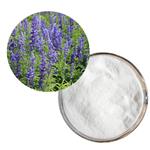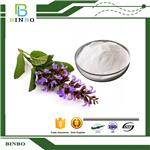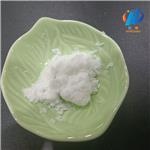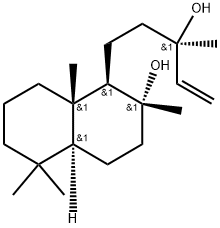- Sclareol
-

- $0.00 / 1KG
-
2024-04-23
- CAS:515-03-7
- Min. Order: 1KG
- Purity: ≥98% HPLC
- Supply Ability: 1000KG
- Sclareol
-

- $0.00 / 25kg
-
2024-04-22
- CAS:515-03-7
- Min. Order: 1kg
- Purity: 99%
- Supply Ability: 3000 kg
- Sclareol
-

- $50.00 / 1kg
-
2024-04-18
- CAS:515-03-7
- Min. Order: 1kg
- Purity: 99.10%
- Supply Ability: 5000kg
|
| Product Name: | Sclareol | | Synonyms: | (1R,2R,8AS)-DECAHYDRO-1-(3-HYDROXY-3-METHYL-4-PENTENYL)-2,5,5,8A-TETRAMETHYL-2-NAPHTHOL;SCLAREOL, NATURAL;1-Naphthalenepropanol, alpha-ethenyldecahydro-2-hydroxy-alpha,2,5,5,8A-pentamethyl-, (alphar,1R,2R,4as,8as)-: (1R,2R,4as,8as)-1-[(3R)-3-hydroxy-3-methylpent-4-en-1-yl]-2,5,5,8A-tetramethyldecahydronaphthalen-2-ol;Aids046592;Aids-046592;SALSOLINOL HYDROBROMIDE(RG)(CALL);Sclareol,(1R,2R,8aS)-Decahydro-1-(3-hydroxy-3-methyl-4-pentenyl)-2,5,5,8a-tetramethyl-2-naphthol;SCLAREOL | | CAS: | 515-03-7 | | MF: | C20H36O2 | | MW: | 308.51 | | EINECS: | 208-194-0 | | Product Categories: | Inhibitors;chemical reagent;pharmaceutical intermediate;phytochemical;reference standards from Chinese medicinal herbs (TCM).;standardized herbal extract;Flavors & Fragrances;Natural Plant Extract;Organics | | Mol File: | 515-03-7.mol |  |
| | Sclareol Chemical Properties |
| Melting point | 95-100 °C (lit.) | | Boiling point | 218-220 °C/19 mmHg (lit.) | | alpha | -13 º (c=4, in carbon tetrachloride) | | density | 0.954±0.06 g/cm3(Predicted) | | FEMA | 4502 | (-)-SCLAREOL | | storage temp. | 2-8°C | | solubility | Chlorform, Ethyl Acetate (Slightly) | | pka | 14.49±0.29(Predicted) | | color | White to Off-White | | Odor | at 100.00 %. sweet balsam clary amber woody weedy | | Odor Type | balsamic | | optical activity | [α]25/D 13°, c = 4 in carbon tetrachloride | | JECFA Number | 2029 | | BRN | 2054148 | | InChIKey | XVULBTBTFGYVRC-HHUCQEJWSA-N | | LogP | 5.54 | | CAS DataBase Reference | 515-03-7(CAS DataBase Reference) | | NIST Chemistry Reference | 1-Naphthalenepropanol, «alpha»-ethenyldecahydro-2-hydroxy-«alpha»,2,5,5,8a-pentamethyl-, [1r-[1«alpha»(r*),2«beta»,4a«beta»,8a«alpha»]]-(515-03-7) | | EPA Substance Registry System | Sclareol (515-03-7) |
| WGK Germany | 2 | | RTECS | QK0301900 | | HS Code | 29061990 |
| | Sclareol Usage And Synthesis |
| overview | Sclareol is a white crystalline powder extracted from the stems and leaves of the natural plant, Salvia Sclare L., with a melting point of 95-105 ° C and a weak Amber (Long saliva) aroma, delicate aroma, strong diffusion and long lasting fragrance. It is an ideal raw material for the synthesis of ambergris products. It is mainly used in the synthesis of natural dragon such as sclareolide and Ambroxide substitutes; a smaller amount of sclareol is also used for the allocation of flavors. In the field of medicine, it is used for anti-bacterial, anti-inflammatory, cholagogue, anti-cancer. In the field of pesticides, it is used for the prevention and control of crop rust, powdery mildew, insecticidal, and mediating the activity plant growth and plant defense function. | | Salvia | Salvia is also known as Salvia sclar, rosette sage. With biennial or perennial Labiaceae sage, it is about 1 to 2 meters high. With the lower stem lignification, upright, branched, the whole plant is covered with wholly short hairs. It is unifoliate opposite, ovate or oblong. With verticillate inflorescence, the bisexual flowers are pink or pale purple or white. The bracts are broadly ovate, and corolla appears in snow-blue. Nutlets ovoid, grayish brown, smooth. The flowering period from June to July; seeds mature in July.
It is a sun-loving plant and resistant to cold, drough and barren, but fear of waterlogging. Seedlings are not resistant to shade.
The Origin is southern Europe. China has introduced salvia in the fifties. Now salvias are distributed in Shanxi, Hebei, Henan, Zhejiang and other provinces. The products of salvias which specially grow in the shallow mountainous areas of northern Shanxi, contain high ester aroma and pure, due to the large temperature difference between temperature and humidity in the region, and the altitude which is particularly suitable for the growth of herbal medicine.
Salvia has wide adaptability and cold, drought, barren tolerance. Seedlings are afraid of waterlogging, with the ability of living in-8 ℃ to-10 ℃.Adult plants can tolerate the temperature about-25 ℃. Early flowering period needs to have enough water to get high yield. For the seed propagation, the autumn is more suitable. The raw materials of salvia can be harvested in the late June of the following year. It should be planted in the spring, if the growth environment is parks or gardens. | | Chemical properties | It is a white crystals. Boiling point> 340 ℃, melting point 101-103 ℃, specific rotation-11 °, soluble in 95% ethanol and oil. With a very weak amber aroma and lasting aroma. | | Uses | (1) It is mainly used for the synthesis of ambergris-amber fragrance, and more suitable for perfume and essence when utilizing its aroma-retaining ability for blending.
(2) It is also used for flavor, spices, cigarettes, cosmetics, health food, food additives. | | Uses | antineoplastic, apoptosis inducer | | Uses | Sclareol is used in biological studies as it has anti-inflammatory activity in both lipopolysaccharide-stimulated macophages and λ-carrageenan-induced paw edema model. | | Uses | Sclareol may be used as a starting material in the synthesis of ambergris fragrance chemicals such as ambraoxide, ambrox, methylambraoxide, ambracetal, ambraketal and epiambraketal. It may also be used in the synthesis of (+)-galanolactone, (-)-8-epi-galanolactone and (+)-labdienedial. | | Definition | ChEBI: A labdane diterpenoid that is labd-14-ene substituted by hydroxy groups at positions 8 and 13. It has been isolated from Salvia sclarea. | | General Description | Sclareol, a diterpene compound with a labdane skeleton, is mainly used as a raw material in the fragrance industry. It shows potent cytotoxic and cytostatic effect in human leukemic cell lines. | | Cytotoxicity | IC50 (μg/mL): 16.6 (HeLa), 32.65 (MCF7),65.2 μM (MG63) (Farimani et al. 2014). |
| | Sclareol Preparation Products And Raw materials |
| Raw materials | MANOOL-->1-Naphthalenepropanol,2-(acetyloxy)-a-ethenyldecahydro-a,2,5,5,8a-pentamethyl-,acetate,(aR,1R,2R,4aS,8aS)- (9CI) | | Preparation Products | Bicyclohomofarnesal-->Ambroxane |
|